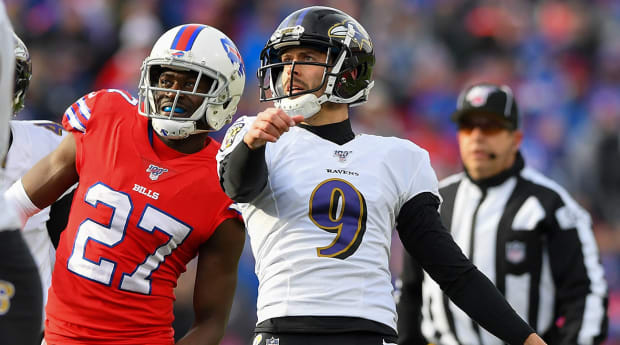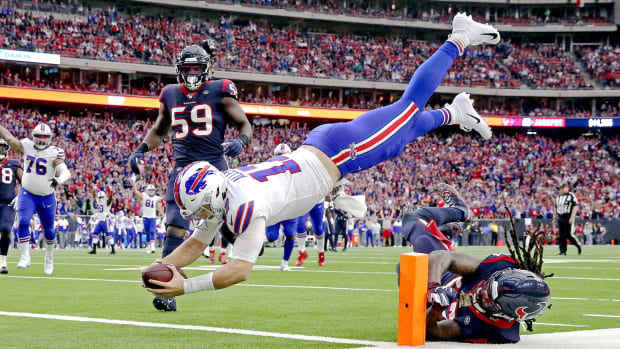Big data has made other sports homogenous and stale. The NFL should at least consider outside-the-box ideas to keep things fresh.
We’ve arrived at an interesting point in major sports, where some of the highest levels of competition have become homogenized and a little predictable. Derek Thompson over at The Atlantic guessed recently that it could be due to a variation of the “Shazam effect,” a term he coined in 2014, where smart people have essentially found a way to utilize efficient data to ruin the beautiful unpredictability of life (in the case of the “Shazam effect” specifically, the kinds of songs you hear on the radio).
Basketball heat maps and baseball’s strikeout and home run numbers can tell a parallel story if you look at them a certain way. Both sports have been so thoroughly studied and refined that, in their purest distillation, there is little room to move beyond what works. There’s a bit of oversimplification there, and no doubt a new trend could come along (or in the case of sports, usually a cyclical revolution), but for now we’re staring down a future that carries some interesting side effects. Basketball, for example, has seen more lopsided victories. It would seem to make sense as teams on the cutting edge jump out front, the rest of the league shuffles behind and, by the time they eventually attain the level of knowledge the top teams possess, there is already some new strain of efficiency to chase. The process repeats itself until we’ve reached baseball after the analytics revolution, where strikeout numbers, home runs and no-hitters dominate all conversations. It’s sort of like a five-car pileup at the Formula One race because all the cars are running at the same, very fast speed and trying to turn in the same direction (and, if you believe baseball largely has a groupthink problem, the cars are being driven by the same person, too).
For some of us, it’s not all bad. We’ve been complaining about baseball in various forms for decades. The ball is too juiced. The ball is not juiced enough. Home runs are great. Home runs are ruining the sport, etc. It’s still enjoyable. Basketball is still enjoyable. It’s just maybe a little less so. Or, enjoyable in a different way, as so many of us have become drawn into the administrative aspects of sports (trades, roster management, drafting) above the sport itself.
Football has been able to avoid this issue in part because of its willingness to goose the rules over time, either blatantly, like the NFL did back in the 1970s (forcing the punt team to remain on the line of scrimmage until after the kick in order to encourage more punt returns), or through the various behind-the-scenes lever pullings of officiating points of emphasis (this past year, for example, holding calls were down; scoring, for a time, was up; and pace of play was better). During the Seahawks’ Legion of Boom era, that group capitalized on the tailwind of a downturn in pass interference calls.
The game has survived some serious swats at homogeneity. The rise of Pete Carroll’s heavily utilized cover-3 defense was swift and widespread but didn’t damage the sport. Bill Walsh’s West Coast offense expanded and contracted in popularity. Kyle Shanahan’s offense, which is now represented in more than a quarter of NFL schemes, will eventually either be countered or expanded upon in a way that makes the new form less recognizable from its base form (much in the way Robert Saleh’s defense has its foundational groundings in Carroll’s defense but has been flavored differently and improved upon).
That said, the NFL shouldn’t get complacent. A few weeks back, a listener of The Weak-Side Podcast emailed colleague Jenny Vrentas and me about a desire for “doink points” in the NFL. Basically, the proposal was to give teams an extra point for every time the ball hits the upright or the crossbar on a made extra point or field goal, in addition to the typical points you would get for the ball making it through successfully. As silly as it sounds on the surface, the idea provides an entryway into a solution for problems the NFL doesn’t yet know it might have.

By allowing more points to come from different places, or by allowing teams different avenues to vault themselves back into games, you can, somewhat effectively, safeguard the game from becoming stale. For example, even the most woebegone franchise might be able to stay afloat in more games whether it had a kicker who was scoring four points a clip, or, in the rare event of a touchdown, eight points.
The solution doesn’t have to be “doink points,” though. Maybe a team could get an extra point for a nonquarterback throwing a touchdown pass. Maybe a team could get extra points for the distance from which it scores. Maybe field goals could be scored in tiers, and, if the goalposts narrowed, could provide an increased number of points based on the distance from which a particular kick is booted. Maybe two-point conversions could be awarded on a make-it-take-it basis. You score two points, you get to line up and do it again. We already saw version 2.0 of the XFL offer one-, two- and three-point conversions, with teams choosing where to line up.
The past two years, the NFL has tabled fourth-and-15 proposals brought forth by teams that would like to see an alternative proposed to the onside kick (in this case, a trailing team can attempt a fourth-and-15 from its own 20-yard line in lieu of an onside kick that has little percentage of success). It seemed the pushback was from teams that believed certain clubs (my guess at the time, teams like the Chiefs, Bills and Texans, with big-armed, mobile quarterbacks) were better suited for the rule and that it would eliminate the reward of playing 58 good minutes of football.
The counter to that, from a business perspective, is that closer games, thrilling comebacks and more scoring are all good for the product. Testing and implementing various new point streams, be it an upright-and-in field goal, a second or third straight two-point conversion or an added bonus for a trick-play touchdown pass, would give the league a chance to effectively whittle down its average margin of victory (which, in 2020, was 10.6 points). Over the past 10 years, the average margin of victory has been as high as 12.7 (’14) and as low as 10.2 (’16), but never to the point where it was within the margin of one traditional score.
It’s not hard to see a world where that margin of victory increases. Let’s say, for example, the Shanahan offensive matchup theory gets adopted by half of the NFL, with enough somewhat qualified candidates around to run its most basic tenets. Teams adopting the system typically score more. Teams refusing to commit lag behind, mirroring basketball during the initial three-point boom. Or, maybe a talented front office will get raided and some of its core principles then begin to spread around the league like wildfire (the Ravens, for example, who have a brilliant and sustainable plan that could work more effectively across all teams; unlike the Patriots’ front office, which has been mined extensively but revolves around two exceptional individuals). Before long, we’d be in a place where most teams look the same, feel the same and draft the same. A place that is just fine.

Expanding the ways in which teams can score (and the players who can score those points) could fend off that staleness. Think about this coming year in particular. As a Lions fan, would you be even the slightest bit more optimistic if you knew that, despite your team’s myriad deficiencies, you had a great—potentially top-five—offensive line and that, in the relatively fewer occurrences that you will score, you have a better chance of continually scoring make-it-take-it two-point conversions based on the one strength your team actually has?
Or, if you’re a complete disaster of a franchise with no ascending talent, you could scour the world not just for a kicker who could hit from 60 yards with some kind of regularity, but the trick shot YouTube kickers who can doink dependably.
None of this would significantly change the balance of power in the league, and it could easily increase the margin of victory as quickly as it could shrink it if teams aren’t careful. Good teams will find a way to stay good. Mediocre teams will find a way to stay mediocre. But the hope would be that they’re less significantly punished for years of poor roster mismanagement and bad coaching, and can probably win a few more games than they deserve. And all the while we’ll stave off a time when we flip on a game and immediately change the channel, convinced that we’ve seen this thing before.
More NFL Coverage:


0 Comments